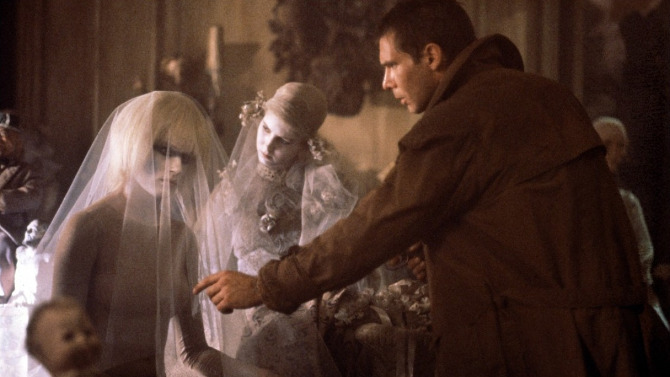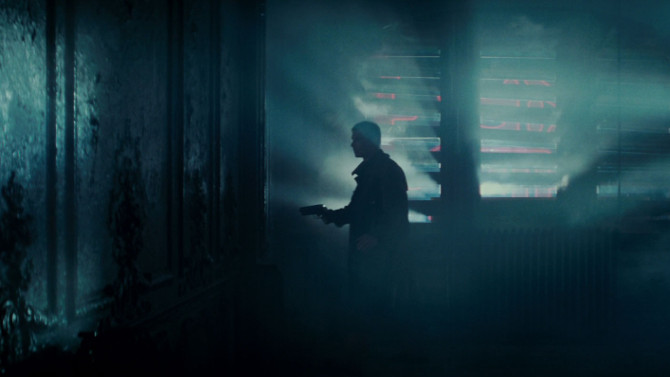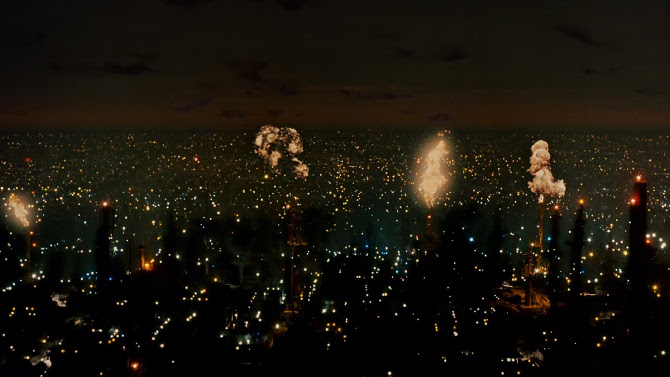The last few years have been a dream for fans of films and television series of the 1980s and 90s, as it seems like more and more are getting sequels (often after many long years), usually with at least a portion of the original cast (and often the director back in either the same role or that of producer) returning to play a part left behind long ago. Think, in no particular order, Dumb and Dumber, Full House, Mad Max, Rocky (Creed), Star Wars, Wet Hot American Summer (actually early 2000s), Jurassic Park, and, as of this Friday, add Blade Runner to the list.
Returning to the silver screen thirty-five years after the original, Ridley Scott this time puts his executive producer cap on, with Denis Villeneuve taking over directorial efforts, while Harrison Ford delves into the Rick Deckard character once again. . . though, you’ll have to wait to hear more on that. As a lead-in to the long awaited sequel, the original 1982 picture is the focus today.
A little while back, I chatted with Tia Carrere about her favourite film. Her big break came on General Hospital, where she played Jade Soong Chung, granddaughter of the head of the Wu crime syndicate, from 1985 to 1987. Moving on to star as Cassandra, Wayne’s prospective girlfriend in Wayne’s World and its sequel, as well as in other big 90s films like Rising Sun and True Lies, she eventually found herself playing Sydney Fox, an Indiana Jones type, on the syndicated television series Relic Hunter. And, for the kids, she voiced Nani in the Lilo & Stitch franchise and series. Also, for those Dancing with the Stars fans (I must admit, it is not one of my guilty pleasures), Carrere competed on the second season, while adding another reality credit to her resume with season five of The Apprentice.
Her music career must also be mentioned. Seven albums and two Grammy’s later (in 2009 for her album ‘`Ikena’, winning again in 2011 for her Hawaiian record ‘Huana Ke Aloha’), she has carved out a successful niche by channelling her roots.
When the conversation turned to her favourite film, it will be no surprise that Blade Runner topped her list. Citing Ridley Scott’s visionary direction, its near dystopic vision and a quality performance from Harrison Ford, she has been hooked since first seeing the film so many years ago.
With an undeniable cold charm, like that which comes from the alluring cool hue of neon (which can be found adorning the signs and windows of this futuristic vision of Los Angeles circa November 2019), this near dystopic tale transports the viewer into its world, the camera literally forcing us slowly forward into the eye of the figurative hurricane, enveloped by this futuristic vision.
It is a future that sends a shiver down the spine, technology grandly depicts advertising and messages to the masses on giant screens that fly overhead or sit on walls, and there is a frigid feel to the city. Dark, rainy and dirty, Scott selects a blueish hue that, when mixed with the atmospheric, shadowy cinematography by Jordan Cronenweth, provides a film noiresque vibe that warns of imminent danger round every corner.
Protagonist Rick Deckard (Harrison Ford) is an ex-special police officer, known as a Blade Runner, a man who hunts down human-like machines known as Replicants (who are used as work slaves on other planets and are not allowed to return to Earth). Developed by the Tyrell Corporation, their technology has made the robots nearly undetectable to the human eye (the only standout feature are shining eyes. . . they utilized the Schüfftan Process which was invented by Fritz Lang – light goes into the actor’s eyes by way of a piece of half-mirrored glass placed at a forty-five degree angle to the camera).
Detained by officer Gaff (Edward James Olmos), Deckard is brought to his former supervisor, Bryant (M. Emmet Walsh), who ropes him back in for another job. There are four Replicants who have escaped their posts, killing in the process. Returning to Earth to “meet their maker” – which, in turn, they hope will help them further their lives (as they only operate for a four year span), their extermination (called ‘retirement’) is of the utmost importance.
Meeting with Dr. Eldon Tyrell (Joe Turkel) and his assistant Rachel (Sean Young), Deckard delves once again into a job that is not exactly easy on one’s psyche. The four Replicants that he is tracking are: wise leader Roy Batty (Rutger Hauer), basic pleasure model Pris (Daryl Hannah), super strong Leon (Brion James), and Zhora (Joanna Cassidy), whose beauty is a deceptive cover for her strength and violent streak. They soon start to track down Tyrell Corporation employees, Hannibal Chew (James Hong) and J.F. Sebastian (William Sanderson), looking for a way up to the big boss.
With philosophy at its narrative core, Blade Runner ruminates on life and death as well as humanity and the soul, making the audience question our own existence and reality. Utterly mysterious, we are constantly off-kilter when it comes to the characters, as it seems like, in this bizarre world, each and every person could be a Replicant. It says something in that, thirty-five years later, many people are still debating whether Rick Deckard is a Replicant or not. Perhaps the most fascinating analysis revolves around the Roy Batty persona. Closing in on his last days of life, he has developed a very human-like perspective (arguably even having empathy), showing a thirst for living. In one of the film’s most important moments, he expounds, “I’ve seen things you people wouldn’t believe. Attack ships on fire off the shoulder of Orion. I watched C-beams glitter in the dark near the Tannhauser gate. All those moments will be lost in time. . . like tears in rain. . .”. As if from the mouth of one of the great poets, it is a reflection on life, its beauty, and the melancholic loss of memory that evaporates with one’s possible impending death. History and experiences lost, never to be recovered. In many ways, this ties in to another quote, this time from Gaff, when he exclaims, “it’s too bad she won’t live! But then again, who does?”. Contemplations on death have been with us for as long as we have been on this Earth, so it is of no surprise that these Replicants, evolving into their own form of human, would have the same thoughts, the same drive to know and understand. Hence, their desire to track down their maker, Dr. Tyrell, is a way of hope, as it may give them a way to prolong their existence – a tradition very much rooted in religion and spirituality. And, like many of the great films, it leaves us not only pondering all these questions, but also with a conclusion that forces us to discover, in our own mind, just what will happen to these characters and if they really are what we are being shown.
 With visual effects that still stagger, Scott’s brilliant fusion of film noir and sci fi mixes to create a unique landscape. Ford’s Deckard is very much like a hard boiled detective, disenchanted by his job and life (voice over narration is even provided in certain versions of the film). Rachel, as well as the Replicants, can be considered a femme fatale figure. Artistic uses of chiaroscuro (cinematography with a strong tonal contrast between dark and light) are found throughout, adding style, substance, mystery and mood to the piece. This subtle direction flows under the surface while the overt sci fi elements are more evident. Flying cars, futuristic advertising, claustrophobic high-rises, creative inventions and life-like Replicants add to this 2019 Los Angeles, a world that feels bigger and less warm. As to the dystopic feel, there is a constant police presence (resembling something like “1984”), environmental degradation (genetically created animals), corporate domination and rampant poverty. Sebastian’s apartment, in an historic old building, is a perfect example of the noirish design, which, when fused with its dilapidated futurist condition as well as the toys he tinkers with which offer the sci fi elements, demonstrates all of the creative themes at work.
With visual effects that still stagger, Scott’s brilliant fusion of film noir and sci fi mixes to create a unique landscape. Ford’s Deckard is very much like a hard boiled detective, disenchanted by his job and life (voice over narration is even provided in certain versions of the film). Rachel, as well as the Replicants, can be considered a femme fatale figure. Artistic uses of chiaroscuro (cinematography with a strong tonal contrast between dark and light) are found throughout, adding style, substance, mystery and mood to the piece. This subtle direction flows under the surface while the overt sci fi elements are more evident. Flying cars, futuristic advertising, claustrophobic high-rises, creative inventions and life-like Replicants add to this 2019 Los Angeles, a world that feels bigger and less warm. As to the dystopic feel, there is a constant police presence (resembling something like “1984”), environmental degradation (genetically created animals), corporate domination and rampant poverty. Sebastian’s apartment, in an historic old building, is a perfect example of the noirish design, which, when fused with its dilapidated futurist condition as well as the toys he tinkers with which offer the sci fi elements, demonstrates all of the creative themes at work.
In a sense, it is rather surprising that Blade Runner is getting a sequel. Costing 28 million to make, it only grossed a little over 26 upon its first run – having the unfortunate luck of being released a few weeks after the phenomenon that was E.T. the Extra-Terrestrial, which earned 792.9 million worldwide. A testament to the quality of Blade Runner, it has only grown over the years, finding new fans with each generation.
As a final interesting note, there is supposedly a ‘Blade Runner Curse” in regards to the advertisements found in the film. Pan Am and Atari closed, while RCA was dismantled, Bell Phones monopoly was broken, Coca Cola suffered huge losses in 1985 with New Coke, Cuisinart filed for Bankruptcy eight years later (though it survived and thrived), while Tsingtao beer is the only company that has not had a hiccup since the film’s release.
A loose adaptation of Philip K. Dick’s “Do Androids Dream of Electric Sheep?”, Blade Runner is a thought-provoking visual spectacle. Featuring a mesmerizing electronic synthesizer score (with some classical composition elements) by Vangelis, breathtaking performances, stunning direction, and a thought-provoking story, Blade Runner is still just as impressive today as it once was. So, check out this sharp 80s classic, it’s well worth running it down.



